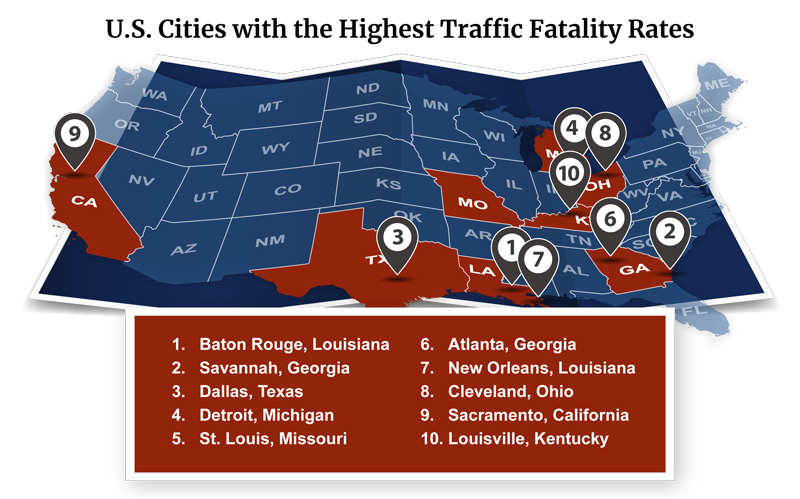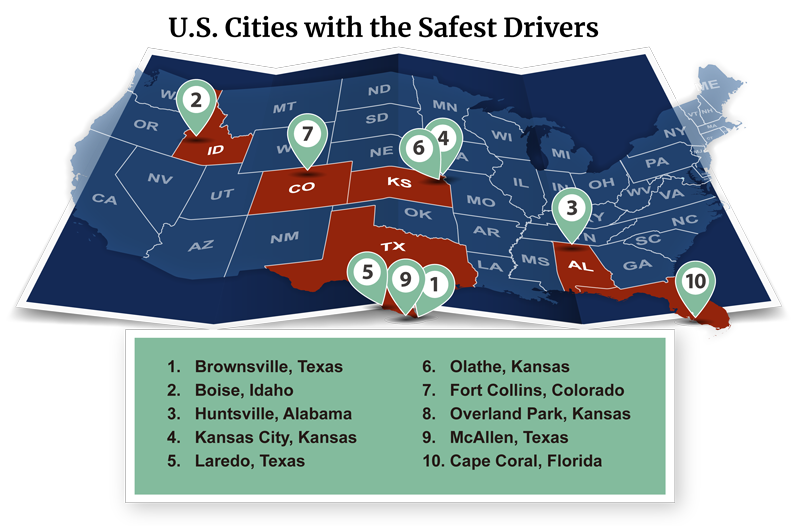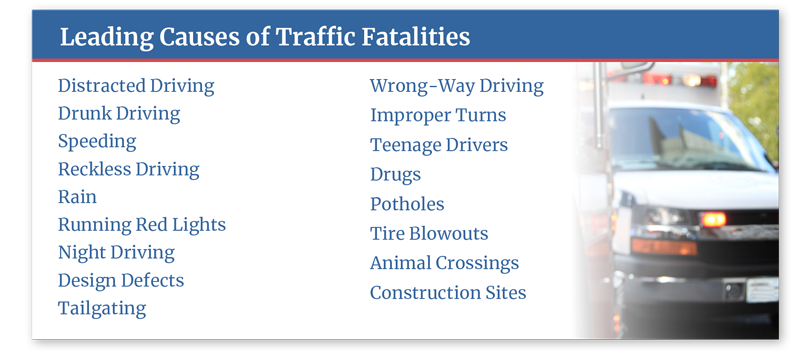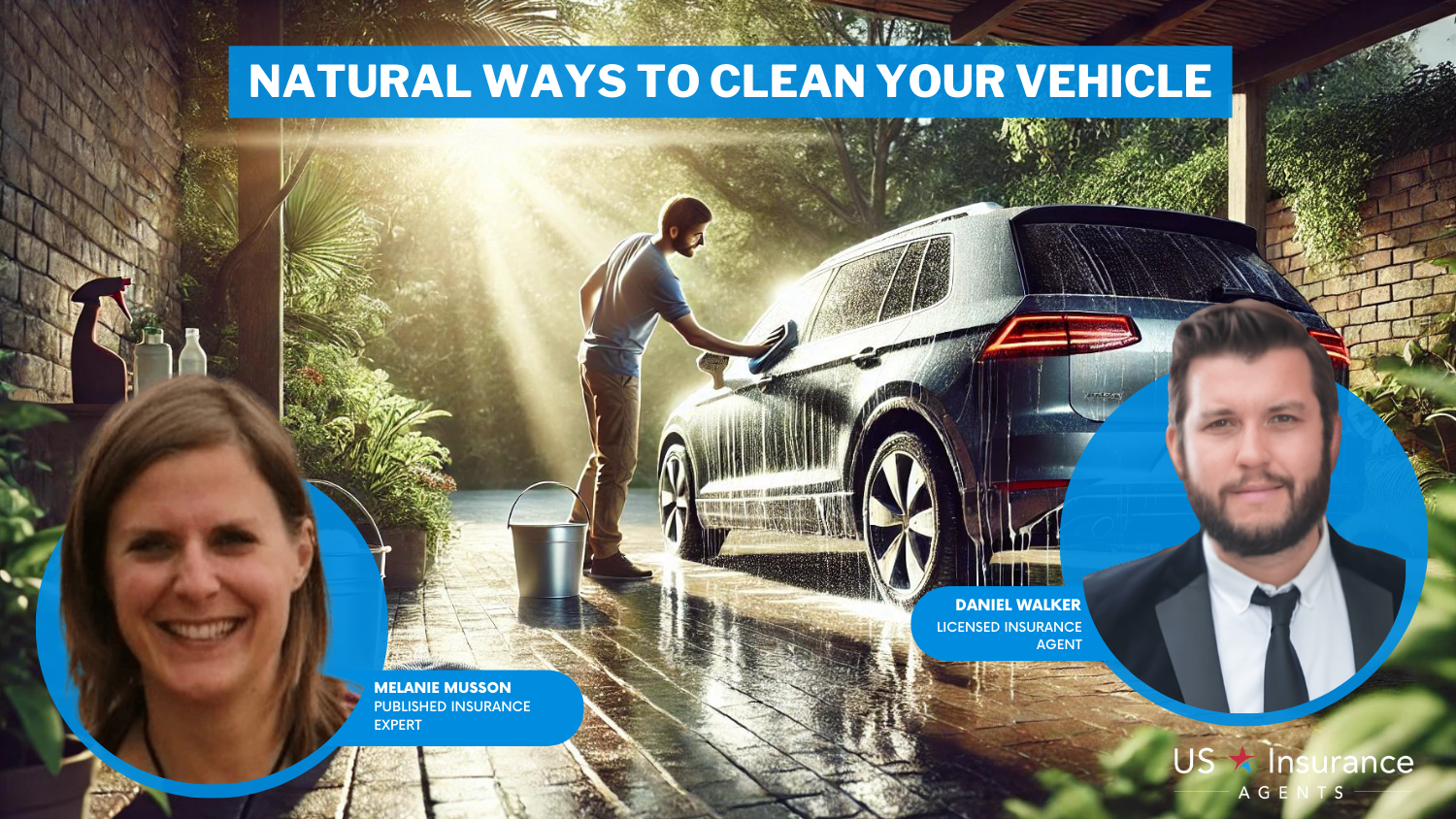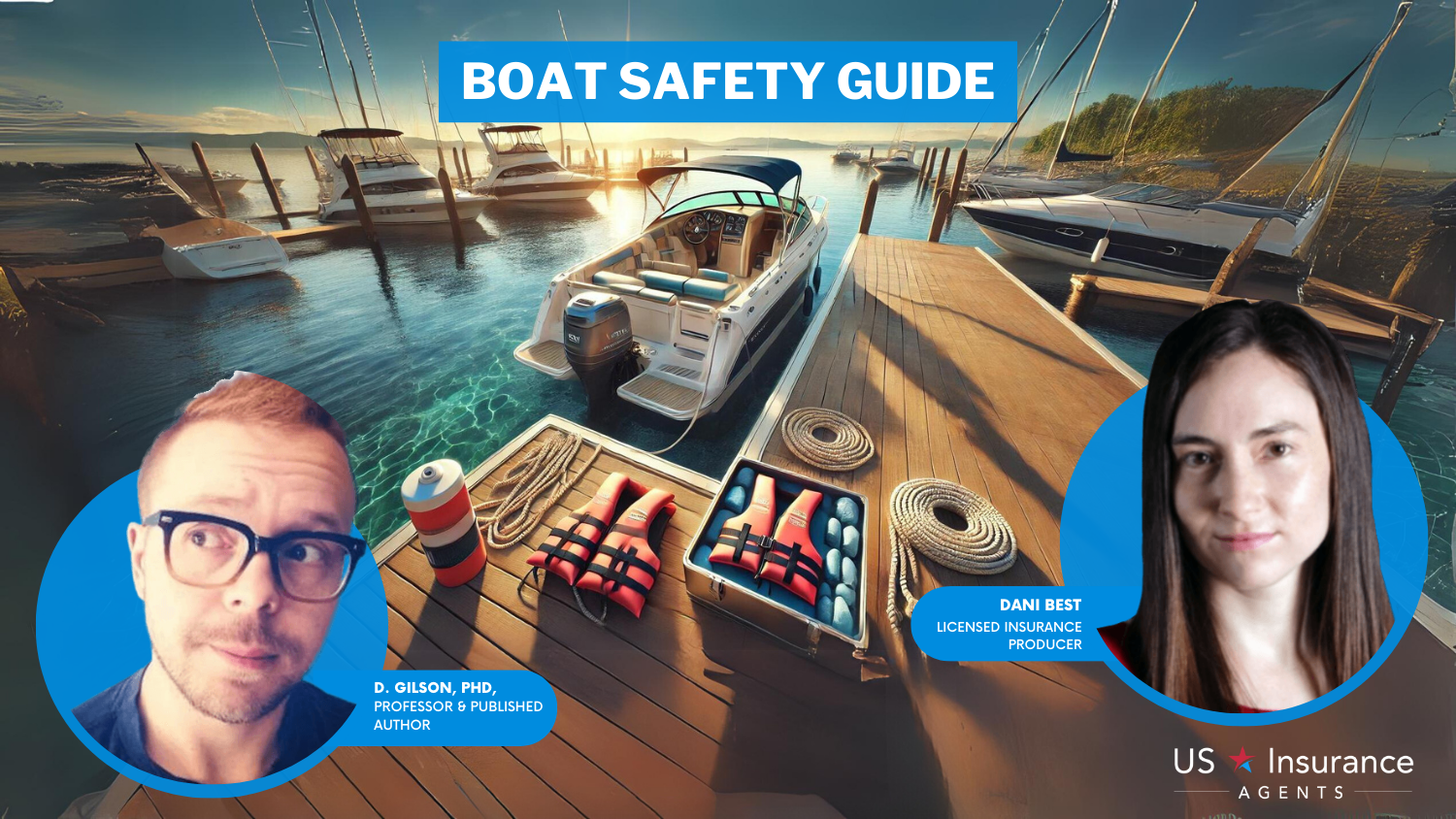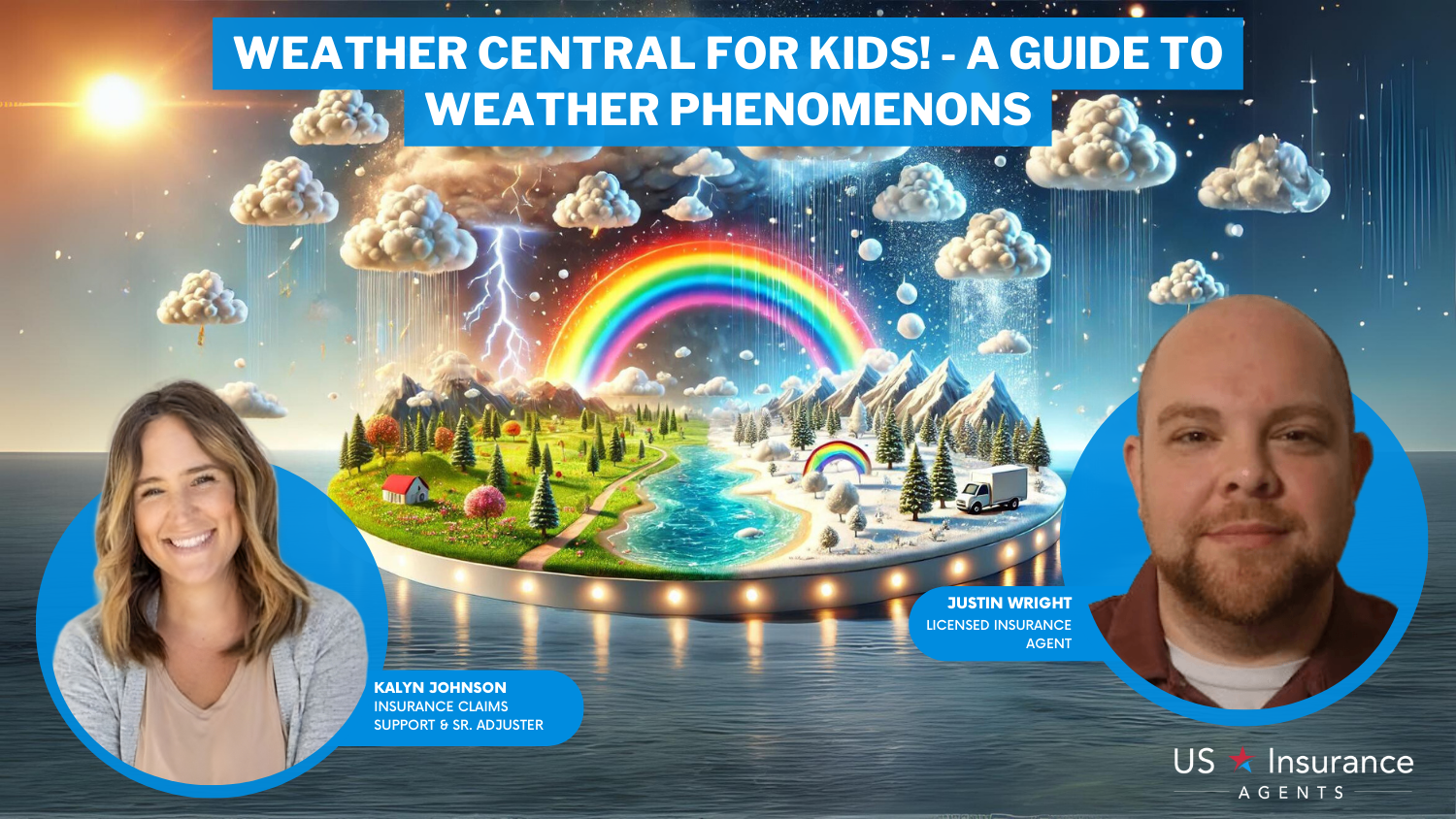10 Deadliest Cities for Drivers
Gain valuable insights into the 10 deadliest cities for drivers and how it impacts insurance rates. Discover the accident-prone areas where drivers face higher risks and explore the potential implications on your insurance premiums. Trust your go-to resource for reliable information and expert advice on navigating the complex world of insurance.
Read more Secured with SHA-256 Encryption





Table of Contents
Table of Contents


Insurance Content Team Lead
Tonya Sisler has been a technical insurance writer for over five years. She uses her extensive insurance and finance knowledge to write informative articles that answer readers' top questions. Her mission is to provide readers with timely, accurate information that allows them to determine their insurance needs and choose the best coverage. Tonya currently leads a team of 10 insurance copywrite...
Tonya Sisler


Sr. Director of Content
Sara Routhier, Senior Director of Content, has professional experience as an educator, SEO specialist, and content marketer. She has over 10 years of experience in the insurance industry. As a researcher, data nerd, writer, and editor, she strives to curate educational, enlightening articles that provide you with the must-know facts and best-kept secrets within the overwhelming world of insurance....
Sara Routhier


Licensed Insurance Agent
Dan Walker graduated with a BS in Administrative Management in 2005 and has been working in his family’s insurance agency, FCI Agency, for 15 years (BBB A+). He is licensed as an agent to write property and casualty insurance, including home, life, auto, umbrella, and dwelling fire insurance. He’s also been featured on sites like Reviews.com and Safeco. He reviews content, ensuring tha...
Daniel Walker
Updated October 2024
Welcome to our comprehensive article on the “10 Deadliest Cities for Drivers (+Insurance Implications)”.
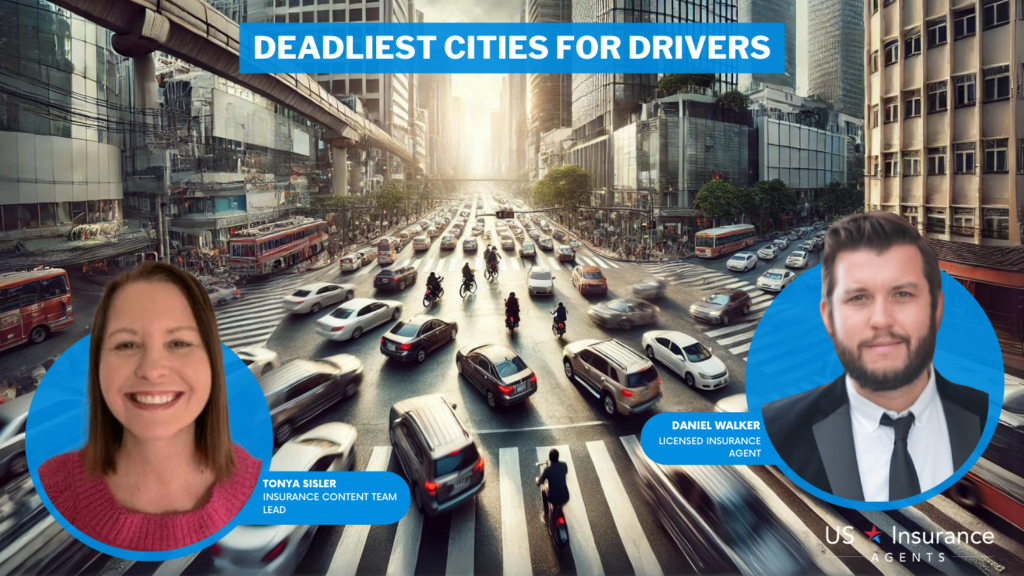
In this informative piece, we delve into the top cities where drivers face the highest risks on the road, along with the implications it has on insurance rates.
- Each year, over 37,000 Americans die in traffic-related crashes
- Six of the 10 deadliest cities for drivers can be found in the South
- Distracted driving and drunk driving are leading causes of traffic deaths
We also analyze the specific challenges each city presents, providing you with valuable insights to make informed decisions about your insurance coverage. To ensure you’re getting the best rates, we invite you to enter your zip code and compare quotes from top insurance providers. Don’t miss out on this opportunity to protect yourself and your vehicle while saving money.
The U.S. Census Bureau reports that there are currently over 122 million vehicles on America’s roads and highways, interstates and other thoroughfares.
That’s a lot of cars, trucks, vans, and other vehicles surrounding us every day.
Accidents are bound to happen with that many vehicles. It can be scary to contemplate if you’ll be next.
That’s why we’ve created this ranking, to cover the 10 deadliest cities for driving in the US.
Here are some of the numbers. In an August 2019 report, the National Highway Traffic Safety Administration (NHTSA) found that in the first quarter of 2019 alone, “an estimated 8,110 people died in motor vehicle traffic crashes” across the United States.
The table below offers some other key accident-related annual averages provided by the NHTSA in their 2019 report.
U.S. Crash Statistics
| DEATH & DISABILITY | ECONOMIC COST |
|---|---|
| Over 37,000 people die | Accidents cost the U.S. approx. $230.6 billion |
| 2.35 million people are injured or disabled | Accidents cost each citizen approx. $820 |
| Over 1,600 children die | An alcohol-impaired fatality occurs every 48 minutes |
| 2 million drivers experience a permanent injury | DUI costs average $3,294 per charge |
As you can see, traffic accidents cause a tremendous amount of death, injury, and economic destruction. Traffic accidents truly are a public health crisis we must address, lest these results worsen.
We conducted this study to share where the 10 deadliest cities for drivers in the United States. The 10 deadliest cities for drivers aren’t just about America’s worst drivers. Living in these cities can drive up your car insurance rate as well.
While we’re going to focus on America’s worst cities to drive in, we’re going to share the safest cities to drive in as well. The best cities to drive in are a contrast with their opposites—the most difficult places to drive in—when it comes to fatal crashes and economic damages from accidents.
There’s another contrast as well: The best cities for drivers often have some of the lowest insurance rates. Finding the best auto insurance can be tricky, as often it is a match between the coverages you want and your budget.
Many compare car insurance between different companies to find the right situation for them. It is perhaps the easiest and quickest way to save on car insurance rates and to find the right auto insurance company for you.
Now, let’s get to the ranking. Ready? Let’s dive in.
Deadliest U.S. Cities
You might think that the deadliest U.S. cities are our country’s biggest cities — places such as New York City, Los Angeles, Chicago, Houston, Phoenix, and Philadelphia. But in reality, the deadliest cities for U.S. drivers range across a slew of mid-sized metros.
The table below provides the 10 deadliest cities in the United States for drivers in 2018, according to the Casper Star-Tribune:
Deadliest U.S. Cities 2018 for Drivers
| CITY | FATALITY RATE | TRAFFIC DEATHS | RANK |
|---|---|---|---|
| Baton Rouge, LA | 23.1 | 52 | 1 |
| Savannah, GA | 15.7 | 23 | 2 |
| Dallas, TX | 14.5 | 194 | 3 |
| Detroit, MI | 15.3 | 103 | 4 |
| St. Louis, MO | 18.1 | 56 | 5 |
| Atlanta, GA | 11.3 | 55 | 6 |
| New Orleans, LA | 11.2 | 44 | 7 |
| Cleveland, OH | 13.7 | 53 | 8 |
| Sacramento, CA | 13.7 | 69 | 9 |
| Louisville, KY | 14.3 | 89 | 10 |
In this table, the fatality rate is deaths per 100,000 residents and the number of motor vehicle deaths is for the year 2018. The Casper Star-Tribune identified the cities with most car accidents through a composite score. They came to this composite score based on four weighted factors:
- Motor vehicle fatality rate (50%)
- Relative collision likelihood (30%)
- Motor vehicle theft rate (10%)
- Annual days with precipitation (10%)
These cities represent a broad range of demographics. Included here are smaller cities such as Savannah, Georgia, population 146,449, and major metro areas such as Dallas, Texas, population 1,341,103.
There are cities in the South, such as Baton Rouge, Louisiana, and on the West Coast, such as Sacramento, California. The cities on this list, in fact, are as diverse as the factors that make a bad driver.
All these cities share at least one thing: they have consistently shown to have higher-than-average danger and fatality rates for drivers.
But what about the motor fatality statistics for American cities beyond the top 10? The table below provides statistics for 183 of the 200 most populous U.S. cities:
U.S. Traffic Death Cities Study
| CITY | DEATH RATE | TRAFFIC DEATHS | CRASH LIKELY % | THEFT RATE | VEHICLE THEFTS | PRECIP. DAYS | RANK |
|---|---|---|---|---|---|---|---|
| Baton Rouge, LA | 23.1 | 52 | 0.551 | 440 | 991 | 113 | 1 |
| Savannah, GA | 15.7 | 23 | 0.378 | 642 | 940 | 110 | 2 |
| Dallas, TX | 14.5 | 194 | 0.465 | 590 | 7,913 | 79 | 3 |
| Detroit, MI | 15.3 | 103 | 0.228 | 1,212 | 8,155 | 135 | 4 |
| St. Louis, MO | 18.1 | 56 | 0.224 | 879 | 2,713 | 110 | 5 |
| Atlanta, GA | 11.3 | 55 | 0.494 | 678 | 3,297 | 115 | 6 |
| New Orleans, LA | 11.2 | 44 | 0.491 | 644 | 2,531 | 114 | 7 |
| Cleveland, OH | 13.7 | 53 | 0.189 | 881 | 3,395 | 156 | 8 |
| Sacramento, CA | 13.7 | 69 | 0.4 | 542 | 2,718 | 57 | 9 |
| Louisville, KY | 14.3 | 89 | 0.162 | 622 | 3,864 | 124 | 10 |
| Springfield, MA | 11.0 | 17 | 0.817 | 329 | 509 | 100 | 11 |
| Memphis, TN | 15.2 | 99 | 0.168 | 614 | 4,002 | 108 | 12 |
| Charlotte, NC | 12.0 | 103 | 0.359 | 305 | 2,622 | 112 | 13 |
| Fort Lauderdale, FL | 16.7 | 30 | 0.068 | 514 | 925 | 145 | 14 |
| Hialeah, FL | 12.5 | 30 | 0.26 | 286 | 685 | 138 | 15 |
| Mesquite, TX | 11.1 | 16 | 0.384 | 590 | 849 | 79 | 16 |
| Hollywood, FL | 14.3 | 22 | 0.149 | 329 | 505 | 145 | 17 |
| Pomona, CA | 11.8 | 18 | 0.34 | 817 | 1,250 | 27 | 18 |
| Houston, TX | 10.6 | 245 | 0.38 | 501 | 11,596 | 103 | 19 |
| Cincinnati, OH | 8.6 | 26 | 0.476 | 493 | 1,485 | 132 | 20 |
| Fort Worth, TX | 12.6 | 110 | 0.297 | 309 | 2,706 | 79 | 21 |
| San Bernardino, CA | 10.1 | 22 | 0.418 | 1,049 | 2,277 | 38 | 22 |
| Portland, OR | 7.4 | 48 | 0.51 | 1,126 | 7,295 | 153 | 23 |
| Fresno, CA | 11.6 | 61 | 0.319 | 529 | 2,789 | 45 | 24 |
| Orlando, FL | 13.2 | 37 | 0.153 | 495 | 1,387 | 117 | 25 |
| Newark, NJ | 9.1 | 26 | 0.32 | 839 | 2,392 | 122 | 26 |
| Greensboro, NC | 16.2 | 47 | 0.119 | 292 | 846 | 111 | 27 |
| Garden Grove, CA | 10.3 | 18 | 0.537 | 377 | 657 | 36 | 28 |
| Jackson, MS | 16.1 | 27 | 0.087 | 447 | 747 | 109 | 29 |
| Charleston, SC | 27.9 | 39 | 0.126 | 217 | 303 | 107 | 30 |
| Jacksonville, FL | 16.3 | 145 | 0.084 | 328 | 2,925 | 114 | 31 |
| Mobile, AL | 16.8 | 32 | -8.40 | 662 | 1,259 | 120 | 32 |
| Salem, OR | 10.6 | 18 | 0.173 | 507 | 861 | 144 | 33 |
| Albuquerque, NM | 15.0 | 84 | 0.053 | 1,376 | 7,684 | 59 | 34 |
| Phoenix, AZ | 15.3 | 249 | 0.136 | 471 | 7,653 | 35 | 35 |
| Anaheim, CA | 9.6 | 34 | 0.488 | 440 | 1,552 | 33 | 36 |
| Milwaukee, WI | 11.8 | 70 | 0.067 | 924 | 5,503 | 125 | 37 |
| Knoxville, TN | 15.5 | 29 | -8.30 | 553 | 1,036 | 127 | 38 |
| Bridgeport, CT | 7.5 | 11 | 0.528 | 488 | 716 | 120 | 39 |
| Bakersfield, CA | 13.7 | 52 | 0.129 | 729 | 2,777 | 37 | 40 |
| Tampa, FL | 13.5 | 52 | 0.172 | 147 | 567 | 107 | 41 |
| Little Rock, AR | 10.6 | 21 | 0.199 | 569 | 1,130 | 104 | 42 |
| Indianapolis, IN | 11.2 | 96 | 0.11 | 572 | 4,904 | 127 | 43 |
| San Antonio, TX | 9.7 | 146 | 0.29 | 454 | 6,864 | 81 | 44 |
| Shreveport, LA | 12.5 | 24 | 0.116 | 461 | 884 | 99 | 45 |
| Nashville, TN | 10.2 | 68 | 0.194 | 385 | 2,565 | 120 | 46 |
| Garland, TX | 8.0 | 19 | 0.484 | 341 | 810 | 79 | 47 |
| Oklahoma City, OK | 14.9 | 96 | 0.006 | 435 | 2,800 | 82 | 48 |
| Stockton, CA | 9.3 | 29 | 0.274 | 660 | 2,049 | 55 | 49 |
| Dayton, OH | 11.4 | 16 | 0.056 | 439 | 616 | 134 | 50 |
| Fontana, CA | 9.4 | 20 | 0.314 | 416 | 881 | 38 | 51 |
| Fort Wayne, IN | 14.1 | 36 | -2.30 | 209 | 532 | 132 | 52 |
| Oakland, CA | 6.6 | 28 | 0.676 | 1,292 | 5,495 | 66 | 53 |
| Waco, TX | 13.9 | 19 | 0.121 | 140 | 191 | 79 | 54 |
| Tulsa, OK | 11.7 | 47 | 0.03 | 860 | 3,460 | 91 | 55 |
| Austin, TX | 8.4 | 80 | 0.391 | 219 | 2,079 | 84 | 56 |
| Torrance, CA | 8.2 | 12 | 0.495 | 297 | 436 | 35 | 57 |
| Columbus, GA | 12.4 | 24 | 0.031 | 363 | 704 | 109 | 58 |
| Grand Rapids, MI | 8.0 | 16 | 0.274 | 183 | 363 | 146 | 59 |
| Baltimore, MD | 5.4 | 33 | 1.524 | 845 | 5,171 | 116 | 60 |
| Tacoma, WA | 6.1 | 13 | 0.339 | 977 | 2,086 | 149 | 61 |
| Hayward, CA | 6.2 | 10 | 0.544 | 1,122 | 1,801 | 65 | 62 |
| Salt Lake City, UT | 10.0 | 20 | 0.078 | 940 | 1,886 | 92 | 63 |
| Santa Ana, CA | 7.2 | 24 | 0.477 | 593 | 1,980 | 36 | 64 |
| Oceanside, CA | 11.4 | 20 | 0.159 | 281 | 496 | 33 | 65 |
| Tempe, AZ | 13.5 | 25 | 0.069 | 256 | 473 | 37 | 66 |
| Columbus, OH | 6.6 | 58 | 0.317 | 474 | 4,176 | 138 | 67 |
| Philadelphia, PA | 5.9 | 94 | 0.669 | 347 | 5,483 | 118 | 68 |
| Killeen, TX | 11.7 | 17 | 0.039 | 389 | 566 | 73 | 69 |
| Buffalo, NY | 6.6 | 17 | 0.337 | 322 | 833 | 167 | 70 |
| Norfolk, VA | 7.8 | 19 | 0.255 | 293 | 718 | 117 | 71 |
| Riverside, CA | 7.9 | 26 | 0.282 | 528 | 1,730 | 30 | 72 |
| Fayetteville, NC | 11.9 | 25 | -0.50 | 198 | 415 | 111 | 73 |
| Los Angeles, CA | 6.4 | 257 | 0.819 | 480 | 19,193 | 35 | 74 |
| Amarillo, TX | 13.0 | 26 | -8.00 | 494 | 990 | 70 | 75 |
| Tucson, AZ | 11.9 | 64 | -1.70 | 449 | 2,407 | 51 | 76 |
| Lexington, KY | 10.9 | 35 | -3.90 | 395 | 1,273 | 133 | 77 |
| Providence, RI | 5.5 | 10 | 0.708 | 322 | 580 | 125 | 78 |
| Glendale, AZ | 9.7 | 24 | 0.147 | 471 | 1,163 | 30 | 79 |
| Chattanooga, TN | 9.5 | 17 | -3.40 | 749 | 1,342 | 120 | 80 |
| St. Petersburg, FL | 10.6 | 28 | 0.028 | 372 | 978 | 97 | 81 |
| Rochester, NY | 7.2 | 15 | 0.228 | 296 | 616 | 162 | 82 |
| Grand Prairie, TX | 7.7 | 15 | 0.324 | 255 | 495 | 70 | 83 |
| Springfield, MO | 10.2 | 17 | -7.70 | 1,176 | 1,969 | 109 | 84 |
| Miami, FL | 9.1 | 42 | 0.045 | 396 | 1,835 | 133 | 85 |
| Paterson, NJ | 6.1 | 9 | 0.333 | 424 | 631 | 123 | 86 |
| Lancaster, CA | 9.4 | 15 | 0.162 | 405 | 650 | 29 | 87 |
| Spokane, WA | 7.4 | 16 | 0.144 | 800 | 1,737 | 112 | 88 |
| Arlington, TX | 6.8 | 27 | 0.399 | 343 | 1,360 | 70 | 89 |
| Moreno Valley, CA | 7.7 | 16 | 0.258 | 559 | 1,158 | 30 | 90 |
| Palmdale, CA | 8.9 | 14 | 0.237 | 276 | 435 | 27 | 91 |
| Toledo, OH | 8.3 | 23 | 0.106 | 269 | 745 | 134 | 92 |
| Newport News, VA | 8.9 | 16 | 0.121 | 272 | 488 | 109 | 93 |
| Las Vegas, NV | 7.0 | 45 | 0.267 | 1,276 | 8,186 | 26 | 94 |
| Syracuse, NY | 7.7 | 11 | 0.139 | 259 | 371 | 172 | 95 |
| Fremont, CA | 6.4 | 15 | 0.412 | 368 | 865 | 65 | 96 |
| Washington, DC | 4.5 | 31 | 1.422 | 367 | 2,545 | 114 | 97 |
| Modesto, CA | 6.1 | 13 | 0.342 | 659 | 1,412 | 56 | 98 |
| Pittsburgh, PA | 5.3 | 16 | 0.419 | 225 | 680 | 154 | 99 |
| Plano, TX | 7.0 | 20 | 0.372 | 119 | 339 | 81 | 100 |
| Worcester, MA | 4.3 | 8 | 1.055 | 214 | 397 | 134 | 101 |
| Vancouver, WA | 5.7 | 10 | 0.222 | 605 | 1,063 | 168 | 102 |
| Long Beach, CA | 5.8 | 27 | 0.454 | 581 | 2,729 | 34 | 103 |
| Pembroke Pines, FL | 7.6 | 13 | 0.166 | 182 | 310 | 122 | 104 |
| San Jose, CA | 4.3 | 45 | 0.446 | 779 | 8,068 | 108 | 105 |
| Wichita, KS | 9.5 | 37 | -6.60 | 634 | 2,478 | 86 | 106 |
| Corpus Christi, TX | 11.4 | 37 | -8.40 | 225 | 731 | 76 | 107 |
| Huntsville, AL | 9.7 | 19 | -21.10 | 535 | 1,046 | 116 | 108 |
| Aurora, CO | 7.1 | 26 | 0.15 | 596 | 2,189 | 87 | 109 |
| Omaha, NE | 8.1 | 38 | -3.00 | 750 | 3,500 | 100 | 110 |
| Escondido, CA | 7.2 | 11 | 0.256 | 262 | 398 | 42 | 111 |
| Chicago, IL | 5.4 | 147 | 0.28 | 426 | 11,578 | 126 | 112 |
| Seattle, WA | 4.1 | 30 | 0.374 | 501 | 3,630 | 156 | 113 |
| Denver, CO | 7.0 | 49 | 0.135 | 789 | 5,560 | 87 | 114 |
| Durham, NC | 7.8 | 21 | 0.105 | 284 | 762 | 105 | 115 |
| Irving, TX | 5.0 | 12 | 0.507 | 296 | 711 | 79 | 116 |
| Boston, MA | 3.8 | 26 | 1.164 | 176 | 1,205 | 127 | 117 |
| Clarksville, TN | 7.8 | 12 | 0.012 | 157 | 241 | 128 | 118 |
| Reno, NV | 8.4 | 21 | -6.10 | 575 | 1,432 | 51 | 119 |
| Akron, OH | 7.1 | 14 | -0.10 | 382 | 755 | 156 | 120 |
| Thornton, CO | 8.0 | 11 | -3.90 | 539 | 739 | 72 | 121 |
| Miramar, FL | 5.7 | 8 | 0.183 | 185 | 260 | 145 | 122 |
| Colorado Springs, CO | 8.4 | 39 | -12.00 | 460 | 2,135 | 89 | 123 |
| Pasadena, CA | 4.2 | 6 | 0.546 | 252 | 359 | 43 | 124 |
| Minneapolis, MN | 4.0 | 17 | 0.289 | 565 | 2,388 | 115 | 125 |
| San Francisco, CA | 2.8 | 25 | 0.555 | 547 | 4,834 | 67 | 126 |
| St. Paul, MN | 3.9 | 12 | 0.289 | 680 | 2,084 | 110 | 127 |
| Fullerton, CA | 4.3 | 6 | 0.532 | 275 | 386 | 33 | 128 |
| Sunnyvale, CA | 4.6 | 7 | 0.443 | 194 | 298 | 64 | 129 |
| Honolulu, HI | 4.9 | 17 | 0.156 | 1,029 | 3,606 | 93 | 130 |
| Orange, CA | 6.4 | 9 | 0.196 | 243 | 341 | 36 | 131 |
| Alexandria, VA | 2.5 | 4 | 0.698 | 171 | 273 | 114 | 132 |
| Chesapeake, VA | 7.5 | 18 | 0.011 | 104 | 250 | 117 | 133 |
| North Las Vegas, NV | 4.1 | 10 | 0.392 | 544 | 1,321 | 22 | 134 |
| Boise, ID | 9.3 | 21 | -22.60 | 153 | 346 | 90 | 135 |
| Rancho Cucamonga, CA | 6.8 | 12 | 0.178 | 207 | 368 | 27 | 136 |
| Corona, CA | 4.8 | 8 | 0.324 | 333 | 559 | 30 | 137 |
| Glendale, CA | 3.4 | 7 | 0.989 | 156 | 317 | 43 | 138 |
| San Diego, CA | 5.2 | 74 | 0.246 | 362 | 5,135 | 41 | 139 |
| Salinas, CA | 5.1 | 8 | 0.144 | 788 | 1,242 | 57 | 140 |
| Tallahassee, FL | 6.3 | 12 | -0.50 | 389 | 744 | 114 | 141 |
| Jersey City, NJ | 5.2 | 14 | 0.197 | 181 | 491 | 107 | 142 |
| Montgomery, AL | 7.0 | 14 | -7.50 | 423 | 844 | 107 | 143 |
| Irvine, CA | 4.3 | 12 | 0.403 | 70 | 194 | 34 | 144 |
| Des Moines, IA | 6.0 | 13 | -1.90 | 579 | 1,260 | 108 | 145 |
| Ontario, CA | 4.0 | 7 | 0.329 | 518 | 911 | 27 | 146 |
| El Paso, TX | 7.3 | 50 | 0.018 | 117 | 800 | 48 | 147 |
| Fort Collins, CO | 7.9 | 13 | -16.10 | 125 | 207 | 87 | 148 |
| Lakewood, CO | 5.8 | 9 | -1.80 | 770 | 1,193 | 78 | 149 |
| Cape Coral, FL | 7.6 | 14 | -13.60 | 93 | 170 | 111 | 150 |
| Mesa, AZ | 7.9 | 39 | -8.90 | 178 | 884 | 35 | 151 |
| Santa Rosa, CA | 5.1 | 9 | 0.149 | 234 | 411 | 81 | 152 |
| Bellevue, WA | 1.4 | 2 | 0.279 | 214 | 309 | 157 | 153 |
| Virginia Beach, VA | 5.6 | 25 | 0.075 | 102 | 459 | 117 | 154 |
| Anchorage, AK | 4.8 | 14 | -5.40 | 1,055 | 3,104 | 115 | 155 |
| Santa Clarita, CA | 4.7 | 10 | 0.251 | 194 | 410 | 29 | 156 |
| Pasadena, TX | 4.6 | 7 | 0.14 | 247 | 379 | 88 | 157 |
| Rockford, IL | 5.4 | 8 | -3.10 | 303 | 450 | 118 | 158 |
| Frisco, TX | 3.4 | 6 | 0.285 | 47 | 84 | 82 | 159 |
| Yonkers, NY | 1.5 | 3 | 0.261 | 90 | 182 | 126 | 160 |
| Chula Vista, CA | 4.1 | 11 | 0.183 | 281 | 761 | 32 | 161 |
| Port St. Lucie, FL | 5.8 | 11 | -10.70 | 46 | 87 | 142 | 162 |
| New York, NY | 2.4 | 207 | 0.198 | 67 | 5,735 | 120 | 163 |
| Sioux Falls, SD | 4.0 | 7 | 0.101 | 265 | 469 | 97 | 164 |
| McKinney, TX | 2.2 | 4 | 0.262 | 85 | 155 | 75 | 165 |
| Laredo, TX | 6.9 | 18 | -18.80 | 65 | 170 | 61 | 166 |
| Brownsville, TX | 6.5 | 12 | -29.30 | 77 | 141 | 72 | 167 |
| Elk Grove, CA | 2.9 | 5 | 0.181 | 123 | 211 | 60 | 168 |
| Eugene, OR | 3.0 | 5 | -2.60 | 323 | 545 | 140 | 169 |
| Huntington Beach, CA | 3.0 | 6 | 0.162 | 191 | 385 | 35 | 170 |
| Scottsdale, AZ | 6.0 | 15 | -9.10 | 98 | 246 | 30 | 171 |
| Joliet, IL | 2.0 | 3 | 0.073 | 112 | 165 | 121 | 172 |
| McAllen, TX | 5.6 | 8 | -14.90 | 32 | 46 | 48 | 173 |
| Naperville, IL | 2.0 | 3 | 0.085 | 32 | 47 | 114 | 174 |
| Aurora, IL | 2.0 | 4 | 0.059 | 87 | 176 | 116 | 175 |
| Henderson, NV | 3.3 | 10 | 0.078 | 212 | 641 | 27 | 176 |
| Madison, WI | 3.5 | 9 | -13.20 | 169 | 432 | 121 | 177 |
| Peoria, AZ | 4.2 | 7 | -2.50 | 141 | 237 | 34 | 178 |
| Overland Park, KS | 4.2 | 8 | -15.00 | 143 | 274 | 66 | 179 |
| Chandler, AZ | 3.9 | 10 | -5.70 | 147 | 372 | 28 | 180 |
| Gilbert, AZ | 3.3 | 8 | -1.60 | 56 | 135 | 30 | 181 |
| Cary, NC | 0.6 | 1 | -12.10 | 43 | 72 | 113 | 182 |
| Olathe, KS | 2.2 | 3 | -16.50 | 111 | 152 | 98 | 183 |
Though these cities range in size and region and demographic makeup, the table above clearly illustrates a concentration of deadly driving cities in California, Florida, and Texas. Not coincidentally, these are three of the fastest-growing states in the country.
Part of driving safely, which we’ll discuss in the next section, is obeying local traffic laws. And in many places, we’ve found that those driving laws can be weird, such as these 13 odd driving laws. Make sure you know the laws of the road wherever you’re driving to remain safe and unticketed.
Free Auto Insurance Comparison
Compare Quotes From Top Companies and Save
Secured with SHA-256 Encryption
Analyzing Traffic Safety: Trends and Statistics
States with the Most Car Accidents
Understanding where car accidents occur most frequently can help in improving safety measures and designing better traffic policies. For instance, the U.S. state with the highest number of car accidents often reflects a combination of high population density, extensive road networks, and varying driving conditions.
Recent data reveals which states have the highest number of car accidents and provides insights into why these states might experience more accidents than others.
Top 10 Most Dangerous Intersections in America
According to State Farm, the Top 10 most dangerous intersections in America highlight areas where frequent accidents occur. These intersections are critical points for traffic management improvements, and identifying them helps in implementing effective safety measures.
Traffic Accident Statistics by City
Analyzing traffic accident statistics by city provides a clear picture of which cities are experiencing higher accident rates. For example, comparing statistics from different cities can reveal patterns and highlight areas in need of better traffic control.
U.S. Cities with the Highest Number of Car Accidents
Among the U.S. cities with the highest number of car accidents, specific urban areas stand out due to their busy traffic conditions and frequent accidents. The U.S. city with the highest number of car accidents is particularly notable for its significant traffic safety challenges.
Traffic Fatalities and Serious Incidents
Traffic fatalities by city and annual traffic fatalities in the US are crucial for understanding the severity of car accidents. Monitoring these statistics helps in gauging the effectiveness of traffic safety campaigns and law enforcement.
Case Studies and Specific Incidents
- Anderson Township car crash: This incident serves as an example of how localized accidents can impact community safety.
- Atlanta accidents: Real-time information about accidents in Atlanta provides current data for understanding local traffic conditions.
- Boston car accidents: Recent accidents in Boston can offer insights into the current state of traffic safety in the city.
- Car accident in Opelika: An example from Opelika highlights the need for safety measures in smaller cities.
Top 10 Most Dangerous Intersections in America (According to State Farm)
According to State Farm, the Top 10 most dangerous intersections in America are identified based on accident frequency and severity. These intersections are notorious for their high rates of collisions, often due to factors like heavy traffic, poor road design, or inadequate traffic signals. Addressing the risks at these intersections through improved signage, traffic management, and engineering changes is crucial for reducing accidents and enhancing safety.
Worst City for Car Accidents
Determining the worst city for car accidents involves analyzing traffic accident data to find the city with the highest rate of accidents. This designation is typically based on the number of collisions per capita, severity of accidents, and overall traffic conditions. Identifying the worst city helps in focusing efforts on traffic safety improvements, public awareness campaigns, and targeted interventions to mitigate accident risks.
By analyzing these factors and statistics, we can gain a comprehensive understanding of traffic safety and the various elements affecting it across different regions.
Where are the safest U.S. cities for drivers?
As important as knowing the deadliest cities for drivers in the United States is knowing the safest cities for drivers. Every year, Allstate releases America’s Best Drivers Report.
This report explores “which cities are least likely to experience collisions” by tabulating collision frequency, the average number of years between collisions, and the relative collision likelihood compared to the national average.
Congrats to Brownsville, Texas, the city we rank as the safest for drivers of all cities across the United States. Many of these cities are great places to call home, to build a business, and naturally, to drive safely.
In the table below, we’ve gathered their 10 safest cities for drivers by rank, location, and population:
| CITY | POPULATION | RANK |
|---|---|---|
| Brownsville, TX | 183,299 | 1 |
| Boise, ID | 226,570 | 2 |
| Huntsville, AL | 194,585 | 3 |
| Kansas City, KN | 152,938 | 4 |
| Laredo, TX | 260,654 | 5 |
| Olathe, KS | 137,472 | 6 |
| Fort Collins, CO | 165,080 | 7 |
| Overland Park, KA | 191,278 | 8 |
| McAllen, TX | 142,696 | 9 |
| Cape Coral, FL | 183,365 | 10 |
As you can see from the table above, mid-size cities tend to rank higher for driver safety. Only two cities on this list — Laredo, Texas, and Boise, Idaho — have a population of over 200,000 people.
In fact, given its relatively small population statewide, Kansas appears to be a fairly safe haven for drivers, with three of its cities in the top 10.
Many of these cities — especially Boise, Idaho; Kansas City, Kansas; Olathe, Kansas; Fort Collins, Colorado; and Overland Park, Kansas — can get quite a bit of snowfall each year. Driving safely in snow requires some knowledge, so we’ve gathered some helpful tips on driving safely in winter.
And even though natural disasters don’t typically eschew data on traffic fatalities, it’s important to know how to drive in a natural disaster, such as floods, hurricanes, tornados, earthquakes, and wildfires.
What causes car accidents?
No two car accidents are alike. Things such as weather conditions and traffic congestion, speed of vehicle and time of day can all combine to determine whether an accident happens in the first place, and then, how severe it is. But we do know that many car accidents have commonalities.
Sometimes optical illusions can affect driving safety. These phenomena include motion-induced blindness, sloping roads and anti-gravity hills, misjudgment of distance and optic flow, vehicle void areas, and blind spots.
And as you can see, certain groups such as teens or senior drivers also need to take particular cautions on the road because they are statistically more likely to be the cause of an accident.
Free Auto Insurance Comparison
Compare Quotes From Top Companies and Save
Secured with SHA-256 Encryption
What age groups die the most in car crashes?
Motor vehicle accidents can kill anyone, from drivers to pedestrians to passengers. But some groups are more likely to die as a result of a car crash. In the latest data available from the NHTSA, we can see that motor vehicle crashes are in the top 10 reasons for death for almost every age group.
The table below gives the rank motor vehicle traffic crashes hold for each age group:
Motor Vehicle Traffic Crash Death Ranks by Demographic
| AGE GROUP | TRAFFIC DEATH RANK |
|---|---|
| Infants under 1 | 9 |
| Toddlers 1-3 | 5 |
| Young children 4-7 | 2 |
| Children 8-15 | 1 |
| Youth 16-20 | 1 |
| Young Adults 21-24 | 1 |
| Adults 25-34 | 3 |
| Adults 35-44 | 5 |
| Adults 45-64 | 9 |
As you can see, young people — particularly children ages 8–15, youth 16–20, and young adults 21–24 — are especially susceptible to dying in a car accident. That’s why we’ve also focused a great deal of our research on car safety for teens and parents.
Many other groups you might not automatically think of, such as cyclists in urban areas, are likelier to die in a crash, too.
And don’t forget: Though they’re rarely talked about when it comes to traffic accidents, it’s important to take steps to ensure your pets’ safety in the car as well.
Are traffic deaths on the rise?
Good question. The National Safety Council has been tracking car crash deaths since 1913. As you can imagine, the number of vehicles in the United States has increased exponentially since then, alongside the American population in general.
It’s a stark reminder that while we see the statistics and have grown accustomed to them, even a single-car accident can cause grief to family, friends, and the community the person who has died belonged to.
The statistics show that most of the time since 1913, car crash deaths have also been on the rise. Fortunately, however, there is some recent evidence that shows how this trend may be slowing, perhaps due in large part to safety initiatives and advanced vehicle safety technology.
Motor vehicle fatalities peaked in 1968 with 54,862 deaths. They haven’t risen above 50,000 deaths again, however, since 1981, which is some good news for American drivers.
The table below provides the statistics on motor vehicle fatalities across the United States from the National Safety Council:
Crash Deaths Since 1913
| YEAR | MOTOR VEHICLE DEATHS | # OF VEHICLES (MILLIONS) |
|---|---|---|
| 1913 | 4,200 | 1.3 |
| 1914 | 4,700 | 1.8 |
| 1915 | 6,600 | 2.5 |
| 1916 | 8,200 | 3.6 |
| 1917 | 10,200 | 5.1 |
| 1918 | 10,700 | 6.2 |
| 1919 | 11,200 | 7.6 |
| 1920 | 12,500 | 9.2 |
| 1921 | 13,900 | 10.5 |
| 1922 | 15,300 | 12.3 |
| 1923 | 18,400 | 15.1 |
| 1924 | 19,400 | 17.6 |
| 1925 | 21,900 | 20.1 |
| 1926 | 23,400 | 22.2 |
| 1927 | 25,800 | 23.3 |
| 1928 | 28,000 | 24.7 |
| 1929 | 31,200 | 26.7 |
| 1930 | 32,900 | 26.7 |
| 1931 | 33,700 | 26.1 |
| 1932 | 29,500 | 24.4 |
| 1933 | 31,363 | 24.2 |
| 1934 | 36,101 | 25.3 |
| 1935 | 36,369 | 26.5 |
| 1936 | 38,089 | 28.5 |
| 1937 | 39,643 | 30.1 |
| 1938 | 32,582 | 29.8 |
| 1939 | 32,386 | 31.0 |
| 1940 | 34,501 | 32.5 |
| 1941 | 39,969 | 34.9 |
| 1942 | 28,309 | 33.0 |
| 1943 | 23,823 | 30.9 |
| 1944 | 24,282 | 30.5 |
| 1945 | 28,076 | 31.0 |
| 1946 | 33,411 | 34.4 |
| 1947 | 32,697 | 37.8 |
| 1948 | 32,259 | 41.1 |
| 1949 | 31,701 | 44.7 |
| 1950 | 34,763 | 49.2 |
| 1951 | 36,996 | 51.9 |
| 1952 | 37,794 | 53.3 |
| 1953 | 37,956 | 56.3 |
| 1954 | 35,586 | 58.6 |
| 1955 | 38,426 | 62.8 |
| 1956 | 39,628 | 65.2 |
| 1957 | 38,702 | 67.6 |
| 1958 | 36,981 | 68.8 |
| 1959 | 37,910 | 72.1 |
| 1960 | 38,137 | 74.5 |
| 1961 | 38,091 | 76.4 |
| 1962 | 40,804 | 79.7 |
| 1963 | 43,564 | 83.5 |
| 1964 | 47,700 | 87.3 |
| 1965 | 49,163 | 91.8 |
| 1966 | 53,041 | 95.9 |
| 1967 | 52,924 | 98.9 |
| 1968 | 54,862 | 103.1 |
| 1969 | 55,791 | 107.4 |
| 1970 | 54,633 | 111.2 |
| 1971 | 54,381 | 116.3 |
| 1972 | 56,278 | 122.3 |
| 1973 | 55,511 | 129.8 |
| 1974 | 46,402 | 134.9 |
| 1975 | 45,853 | 137.9 |
| 1976 | 47,038 | 143.5 |
| 1977 | 49,510 | 148.8 |
| 1978 | 52,411 | 153.6 |
| 1979 | 53,524 | 159.6 |
| 1980 | 53,172 | 161.6 |
| 1981 | 51,385 | 164.1 |
| 1982 | 45,779 | 165.2 |
| 1983 | 44,452 | 169.4 |
| 1984 | 46,263 | 171.8 |
| 1985 | 45,901 | 177.1 |
| 1986 | 47,865 | 181.4 |
| 1987 | 48,290 | 183.9 |
| 1988 | 49,078 | 189.0 |
| 1989 | 47,575 | 191.7 |
| 1990 | 46,814 | 192.9 |
| 1991 | 43,536 | 192.5 |
| 1992 | 40,982 | 194.4 |
| 1993 | 41,893 | 198.0 |
| 1994 | 42,524 | 201.8 |
| 1995 | 43,363 | 205.3 |
| 1996 | 43,649 | 210.4 |
| 1997 | 43,458 | 211.5 |
| 1998 | 43,501 | 215.0 |
| 1999 | 42,401 | 220.5 |
| 2000 | 43,354 | 225.8 |
| 2001 | 43,788 | 235.3 |
| 2002 | 45,380 | 234.6 |
| 2003 | 44,757 | 236.8 |
| 2004 | 44,933 | 243.0 |
| 2005 | 45,343 | 247.4 |
| 2006 | 45,316 | 250.8 |
| 2007 | 43,945 | 254.4 |
| 2008 | 39,790 | 255.9 |
| 2009 | 36,216 | 254.2 |
| 2010 | 35,332 | 250.3 |
| 2011 | 35,303 | 253.2 |
| 2012 | 36,415 | 253.6 |
| 2013 | 35,369 | 255.9 |
| 2014 | 35,398 | 260.3 |
| 2015 | 37,757 | 263.6 |
| 2016 | 40,327 | 268.8 |
| 2017 | 40,231 | 272.5 |
| 2018 | 39,404 | 276.6 |
We hope concentrated safety initiatives continue to lead to a decrease in the number of motor vehicle deaths in the coming years.
One such initiative you might not be aware of: Many car insurance companies will lower your insurance rates if you take a defensive driving course. But let’s take a look at what else is being done to reduce deaths on the road.
What is being done to reduce traffic fatalities?
We know traffic deaths are a national health crisis. Even though there were under 40,000 motor vehicle fatalities in 2018, a year that saw 39,404 such deaths, that is still 39,404 too many fatalities. Let’s take a look at what’s being done to reduce the number of deaths on our roadways.
National Information Campaigns
The Ad Council, an organization that produces public service announcements (PSAs) on behalf of nonprofit organizations and U.S. government agencies, has long focused on informing the public about traffic safety.
By concentrating on drunk driving to driving and texting, they have been a leader in getting the word out about how risky driving behaviors can lead to traffic fatalities. Recently, the Ad Council partnered with the NHTSA to launch a campaign against driving under the influence of marijuana.
Titled “If You Feel Different, You Drive Different,” this campaign directly educates the public on the dangers of driving high as more and more states move to legalize or decriminalize marijuana use.
If you are fighting a drug or alcohol addiction, we’ve gathered some great educational resources about addiction to help you in this fight. Remember: You are not alone.
Safe Driving Incentives
Many car insurance companies offer safe driving incentives. These can be deep discounts for drivers who maintain accident-free or low-risk driving records over time.
An added benefit to your safe driving? You protect both yourself and your fellow drivers on the road. When we all engage in safer driving practices, we work together to reduce the number of motor vehicle fatalities.
Increased Car Safety Technology
As forms of technology are included in our motor vehicles, many of these advances serve to protect us from accidents, reducing motor vehicle fatalities.
According to the St. Louis, Missouri Law Office of Donna Clark Frayne, there are 11 types of new car technologies that help prevent accidents. These include:
- Automatic Emergency Braking (AEB) systems
- Back-up cameras
- Auto-steering
- LED headlights
- Lane departure warning/lane-keeping systems
- Rear cross-traffic alert
- Rear Automatic Emergency Braking (Rear AEB)
- Autonomous Cruise Control (ACC)
- Bluetooth voice control systems
- Forward Collision Warning (FCW)
- Blind-spot warning
As technology evolves, we believe it will continue to change along the lines of current trends: to protect drivers, passengers, pedestrians, and everyone vulnerable to becoming a victim of a motor vehicle fatality.
Safer Paths for Pedestrians and Bicyclists
Vehicle drivers and passengers aren’t the only ones to die in motor vehicle incidents. The Verge reports that in 2019 alone, 6,283 pedestrians died as a result of car crashes, “an increase of 3.4% from the previous year … [and] the highest such number since 1990.”
According to the Insurance Institute for Highway Safety (IIHS) “each year about 2% of motor vehicle crash deaths are bicyclists.” In 2018, this meant that a total of 854 cyclists were killed across the United States in a motor vehicle accident.
The high rates in the United States of pedestrian and bicyclist deaths in a motor vehicle accident are simply unacceptable.
But there is reason for hope. As cities both large and small continue to grow, they are focusing more and more on creating safer paths for pedestrians, whether they are on foot or using wheelchairs, and bicyclists.
Memphis, Tennessee is one of the cities that is using more bike lanes to help save lives and improve the quality of life for the city’s residents.
According to the Bike Law Foundation, the total number of bicycle lanes in the City of Memphis grew from 1.82 miles to 69.34 miles — a 3,710 percent increase from 2010–2015.
The city is continuing to expand its bike paths and bike-only lanes to increase safety and alternative commuting options for Memphis residents.
Free Auto Insurance Comparison
Compare Quotes From Top Companies and Save
Secured with SHA-256 Encryption
What do experts have to say about America’s deadliest cities for drivers?
We asked a variety of industry experts from lawyers to travel guides, urban planners and roadway safety advocates to weigh in on the issue of city driver safety.
Some of the personal stories they told about their cities both surprised and moved us. Read on to find out what they had to say about the deadliest cities in the United States for drivers.
What cities in the United States are deadliest for drivers?
“Atlanta is one city with the deadliest interstates in the state. In 2013 alone, there were 26 fatal accidents in Interstate 285. In November 2019, a website ranked Atlanta-Sandy Springs-Roswell as the 11th metro area with the highest traffic fatalities per 100,000 people at 12.4.
According to statistics by the National Highway Traffic Association, Georgia’s 1,504 traffic deaths in 2018 reflects a 2.3 percent drop from the 2107 statistics, but this has not made the office complacent, considering that the number is still high.”
Why is a city deadly for a driver?
“There are a number of factors such as traffic congestion, high speed driving on the interstate and highway stretches, just to name a few.
Then with the rise of ridesharing, the responsibility of who to blame is even left questionable. In the event of an Uber or Lyft accident, the company can distance itself from the drivers, leaving its users and the communities they serve in a rather complicated situation.
The companies label drivers as independent third-party contractors and not as company employees per se. Uber claims that it is merely the provider of technology that connects the drivers with passengers.
In that position, Uber drivers are technically independent of the company despite the fact that the ridesharing provider facilitates the service entirely.”
What makes it deadly?
“Drivers disobeying traffic laws – Traffic laws are in place to protect drivers and others. If a driver disobeys a traffic law, it is often a negligent act. For example, a driver is negligent if he goes through a red light.
Another common traffic law that people break is the posted speed limit. Speeding is a negligent action because the driver should know that speeding could cause an accident with injuries.
Not maintaining control of the vehicle – Drivers are required to maintain control over their vehicle at all times. If they fail to do so, it may be considered negligent.
For example, a driver is driving at the speed limit, but there is fog in the area and low visibility. If the driver loses control and crashes into another vehicle, it might be negligence.
Distracted driving – Distracted driving occurs when the driver isn’t paying close enough attention to the road. There are three main types of distracted driving, including taking your eyes off the road, taking your hands off the wheel and taking your focus off of driving.
Some common examples of distracted driving include texting, eating, talking to others and using electronic devices. If a driver’s complete attention is not on the road, it may be considered negligence.
Failure to set safety measures – Vehicles are equipped with safety features that are supposed to be utilized when necessary to prevent accidents. The failure to use these features when appropriate could cause an accident and might be a negligent act.
For example, a driver’s vehicle becomes disabled on the road. If the driver fails to put the hazard flashers on and another vehicle hits the car, the driver might be negligent.”
What are cities doing to improve their driver fatality rates?
“Cities have started to resurface lanes, install signs, improve lighting, widen barriers and add 425 flex tube barriers as well to improve traffic flow.
They’ve also launched driver education programs such as the Georgia Governor’s Office of Highway Safety’s (GOHS) Distracted Driving Awareness Month and implemented strict measures such as Georgia’s hands-free law that have decreased fatalities.”
What barriers exist that make safety improvements harder for cities?
“There’s always the notion that drivers think highly of themselves as much better than others. This leads to motor vehicle accidents and injuries. No matter how tough the laws are, it’s difficult to instill in them that safety is always a top priority.
And then there are new types of transportation hitting the road every now and then. In Georgia, electric scooters can go up to 15 miles per hour.
Some of the most common types of electric scooter accidents in Georgia include:
- Defective electric scooters: The most common type of accident that’s been reported in Georgia has to do with defective or malfunctioning electric scooters. Because electric scooters are subjected to heavy wear and tear and consumer abuse, it’s not uncommon for them to malfunction.
- Companies such as Bird and Lime rely on their riders to report problems with the scooter.
- However, many people don’t report problems, and if you’re taken away from an accident scene in an ambulance, you won’t be able to report the defect or malfunction and the scooter is left there for someone else to rent.
- Being chased by a dog: Many breeds of dogs have high prey drives and have been known to chase someone on an electric scooter, causing the rider serious injury.
- Avoiding other objects: Many electric scooter accidents in Georgia are due to the rider attempting to avoid a pedestrian, a motor vehicle, another scooter, road debris, a dog, and/or a bicyclist.
- Pedestrians: In many cases, a pedestrian is hit by an electric scooter or trips on a scooter left abandoned on a sidewalk.
- Other motorists: Sometimes another motor vehicle will swerve to miss something and hit a scooter. In other cases, scooter riders have run into open car doors, a turning vehicle, or a vehicle that is backing up.
Bird and Lime don’t want people operating electric scooters on the sidewalk, but many cities in Georgia don’t want them operated on the streets.
Additionally, there’s a lot of confusion regarding scooters needing a license and registration. Another concern is the sidewalk litter electric scooters are causing in cities like Atlanta.
Because as a rider you can pick up and drop off an electric scooter anywhere, it’s causing the sidewalks to fill up with abandoned scooters that are blocking wheelchair paths and pedestrians from being able to navigate safely.”
What do the deadliest cities for drivers have in common?
“Aggressive drivers are often on the road in these cities. Atlanta shares this characteristic with drivers in Los Angeles, Philadelphia and San Francisco, just to name a few.”
Are deadly cities for drivers concentrated in one region or more evenly distributed?
“This depends but most accidents usually occur on interstates. Georgia’s I-20, I-16 and 1-95 aside from I-285 are notorious for being deadly highways, especially during the summer.”

Luis Scott Jr. is managing attorney of The Bader Scott Law Firm.
His firm specializes in personal injury, workers comp, and car accidents.
“When it comes to driving, a ‘deadly’ city would be one with a higher-than-average instance of fatalities in motor vehicle accidents per capita.
There are many factors that might contribute to a city having higher fatality rates. These factors can include the state of the roads, average speed limits, or even the age demographics of a city. Fatal accidents are far more likely to involve inexperienced teen drivers or fragile senior citizen drivers.
According to data from the National Highway Traffic Safety Administration, the deadliest driving city is Baton Rouge, Louisiana, with 23.1 vehicle fatalities for every 100,000 residents.
In most figures, the Southern United States, particularly Florida, tends to see more fatalities per capita than more Northern states. At a glance it appears that rural roads are more dangerous than urban streets.
A few possible reasons why include the fact that speed limits tend to be higher on average in rural areas, and there may not be as much law enforcement per square mile.
Additionally, few street lights along country roads can make it more difficult to see after dark, and wild animals like deer are more likely to be on rural roads than city streets.
To make streets safer, ‘Vision Zero’ initiatives have shown to be effective in both Montana and New York. ‘Vision Zero’ is a global campaign designed to reduce automotive injuries and deaths, and asks states and municipalities to think critically about their needs and what actions can be taken.
In Montana, lower speed limits have been established, while New York has built more dedicated bike lanes. Both states have seen reduced automotive fatalities.”

Jake McKenzie is the content manager at Auto Accessories Garage.
Auto Accessories Garage is a family-owned retailer of automotive parts.
Why is a city deadly for a driver?
“City driving involves variables that create dangerous situations for drivers and bystanders.
If you aren’t paying attention while driving and/or are driving too fast, you can hit another car, object, pedestrian, etc. Smaller spaces mean crowded streets with a lot of traffic from cars, buses, motorcyclists, etc.”
What makes it deadly?
“Major cities have more cars, pedestrians, and higher speed limits that create hazardous road conditions if you aren’t paying attention.
Drunk driving remains at the top of the reasons for the deadliest crashes in a city. It led to 10,511 deaths in the U.S. in 2018, which accounts for 30 percent of all fatalities on American roads.
Speeding is another top factor for driver fatalities. In 2017, speeding killed over 9,700 people, which accounted for 26 percent of all U.S. driving fatalities.
The faster a driver goes, the more difficult it is to stop the vehicle. Larger cities have higher speeds to allow the high volume of traffic to run smoothly without start-and-stopping.”
What are cities doing to improve their driver fatality rates?
“U.S. cities with less vehicle travel and more mass transport infrastructure have lower rates of driving fatalities. Cities can also incorporate safer bicycling paths on the streets to lower vehicle traffic on the streets.
In addition, safer urban design can reduce vehicle speeds and provide safer streets for pedestrians. Shorter blocks and narrower streets can reduce the chance of pedestrians getting hit by slowing down traffic. In turn, this type of design would lead to fewer wrecks and fatalities.”
What barriers exist that make safety improvements harder for cities?
“The main barriers to making road safety improvements include financial, regulatory, and social barriers. The biggest barriers being financial resources and cost-benefits to continued investment in road safety.
Federal, state, and local governments are involved in investing in roads, and 50 percent of U.S. roads don’t generate enough traffic to pay for themselves in gas taxes. These agencies are just as frustrated as the citizens are with the nation’s road conditions.”
What do most deadly cities for drivers have in common?
“The deadliest cities for drivers are the most populous ones. The nation’s largest and busiest cities are more prone to deadly accidents. Big cities with long commutes, roads designed for max speed, and roads that give pedestrians no place to go but into traffic.
These are just some of the common reasons populous cities are facing high rates of deadly crashes.
Overall, drivers in deadly accidents in every city share in common the fact they do not care about others around them. They ignore warnings to slow down and pay attention to the road.
Many of these drivers are consistently using their phones in the car even after continuous warnings of deadly wrecks occurring because of this.”
Are deadly cities for drivers concentrated in one region or more evenly distributed?
“As a whole, driver fatality rates are higher in the South and Southeast — over 10 cities of the top 20 deadliest U.S. cities for drivers are located in Texas and Florida. Northeast states (Massachusetts, New Hampshire) with older infrastructures and crumbling roads also top the list.”
The Power of Awareness
“One of the most powerful ways to focus public resources on the issue of road safety is awareness campaigns. Technologically-progressive states like Texas and Florida provide a daily public redacted version of their crash data.
With knowledge comes power, and people are using crash data to highlight recurring issues on the roads.
Innovative startups like MyAccident.org are being used by citizens to drive awareness of the most frequent locations for accidents — so that people can be extra careful in these dangerous zones. By getting people involved in the problem, powerful solutions are possible.”

RJ Ammons is the Founder of the public benefit corporation MyAccident.org.
10 percent of their revenue is donated to help those involved in auto accidents.
“The drilling boom in the Permian Basin has made the region around the cities of Odessa and Midland, Texas, one of the most dangerous regions of the United States for traffic fatalities. There are several reasons for this. The topography is flat.
Oilfield semis drive fast, especially down roads intersecting Interstate 20.
Collisions happen at high speed and often involve large semis and smaller vehicles. This adds up to a deadly combination.
Furthermore, the oil business is booming. The United States is set to become an oil exporter. Production volumes are ramping up. West Texas crude is a big part of this. There is no pipeline to export this bounty; loads go by road. No railroad services the area directly either.
Oilfield workers often come from far away. They’ll work many long days in a row. They get very tired. They use copious amounts of caffeine and other substances to help them cope with the demands of their job.
Drivers need to be alert, cautious, and always make sure they’re wearing their seat belt and that their passengers do the same.”
What are the unique aspects of road danger on an area transition from being rural to more developed?
“Several common landscape features increase road danger when a trip transitions from rural to urban and suburban.
- First, there’s a change in allowable speed. This brings a mix of traffic, some of which haven’t slowed down upon entering the more developed area. Drivers don’t always pay attention.
- Second, there are four-way stops and intersections with blinking caution lights. Inattentive drivers sometimes blow right past these intersections and have high-speed collisions.
- Finally, when you get to the outskirts of areas, you’ll find situations where heavy equipment is driving slowly down the road, where people slow down to make turns, pick up their mail, etc. This adds an unpredictable element to driving which also increases accident rates. “
Are medical facilities in place nearby to take care of roadway accident victims?
“There are several fine hospitals in the Odessa/Midland area. None of them, however, are level one trauma centers. The closest trauma center is in Lubbock, Texas, 140 miles away by road.
The most critically injured traffic accident victims need to go to a trauma center where they have all of the resources to take care of them. Trauma centers have all relevant specialties on call 24 hours a day.”
What age group are you seeing facing the most danger on Permian Basin roadways?
“Unlike many fast-growing metropolitan areas, Odessa-Midland isn’t a retirement area. Odessa-Midland is growing because there are a lot of well-paying jobs. Consequently, the age group facing the most danger on Permian Basin roads are working-age adults.
They’re putting the most miles on their vehicles. Working-age adults are the ones driving the rigs and commuting to home, school and work. These days, too, most adults are pretty good about seeing to it that their children are buckled into appropriate car seats. Sometimes they’re not so careful with seeing to it that they themselves are wearing seat belts, however.”
What are the cities/counties/state doing to improve road conditions on the Permian Basin?
“Despite growing rapidly over the last decade, the Permian Basin has only 2 percent of Texas’ population. According to a 2017 study, however, it accounts for 11 percent of traffic fatalities.
The Texas Department of Transportation is going to spend $5 billion to upgrade regional roads over the next 10 years.
Other regional efforts include the Permian Road Safety Coalition. The PRSC is an advocacy group formed by oil and natural gas companies, trucking companies, and other organizations that work together to reduce traffic accidents and fatalities.
This coalition has made donations to improve equipment for first responder units and even to build an overpass on Highway 302 in Kermit, Texas.
Roads can be hard to build and improve, however. Efforts to fix roads face a bidding war against oilfield companies. High school graduates with a commercial driving license can make $200,000 per year with overtime.
This isn’t the Bay Area or Manhattan either, where $200,000 doesn’t go very far. Odessa-Midland is close to the median for cost of living in the United States.”
How quickly have Odessa and Midland grown over the last decade? Projections for growth?
“In the most recent year for which growth rate statistics are available, Midland, Texas, was the fastest-growing city in the United States with a 4.3 percent growth rate. Odessa, Texas, was the fifth-fastest, with a 3.2 percent growth rate.
Between 2010 and 2018, the area’s population grew 26 percent, outpacing Texas as a whole.”
Besides I-20, what roadways are especially dangerous in your area?
“U.S. 285, running from Fort Stockton, Texas, to Carlsbad, New Mexico, is known as ‘Death Highway.’ Other especially dangerous highways include Highway 302 running from Odessa to Kermit, and Interstate 20 that runs through the area.
The area, however, has oil and natural gas drilling all over and drivers can have too-close encounters with vehicles on almost any road.”

James Cobb, RN, MSN is an emergency department nurse.
He is a published author who founded The Dream Recovery System.
What We Learned about the Deadliest U.S. Cities for Drivers
Three distinct Southern cities — Baton Rouge, Louisiana; Savannah, Georgia; and Dallas, Texas — top the charts for deadliest cities for American drivers.
Many of the cities we found to be especially dangerous for drivers are quickly-growing midsized metros, places where roadway infrastructures are attempting to catch up to resident and visitor demand.
The NHTSA reports that on average, over 37,000 people die in road accidents each year. So it’s important to know all you can about roadway safety, which is part of being a good roadway citizen.
Conversely, the safest cities for drivers in the United States are in an array of regions, including the South, Midwest, and West, especially. The vast majority of these cities had a population between 100,000 and 200,000 people.
Regardless of city, young people are especially prone to traffic fatalities, and distracted driving, drunk driving, and speeding still top the list of reasons why traffic accidents happen.
The good news is, concentrated safety initiatives and incentives, alongside advancing automobile technology, are showing some hope that traffic fatalities are on the decline in the United States.
Free Auto Insurance Comparison
Compare Quotes From Top Companies and Save
Secured with SHA-256 Encryption
Methodology: Determining the Deadliest Cities for Drivers
In our study of the deadliest cities for drivers in the United States, we relied most heavily on data collated by the National Highway Traffic Safety Administration (NHTSA).
The NHTSA developed their composite scores on driving safety by looking at motor vehicle fatality rates, the relative collision likelihood in comparison to national averages, motor vehicle theft rates, and an area’s weather conditions, which greatly impact the likelihood of car crashes and these car crashes’ seriousness.
In addition to data from the NHSTA, we conducted our study using primary research from the U.S. Census Bureau, the Casper Star-Tribune, Allstate’s America’s Best Drivers Report, the National Safety Council, the Ad Council, and the Insurance Institute for Highway Safety (IIHS).
Ultimately, we determined the deadliest cities for U.S. drivers based on a city’s fatality rate. By fatality rate, we mean the number of traffic-related fatalities per year per 100,000 residents.
Cities with more car accidents, tickets, or vehicle thefts are likely to have higher auto insurance rates than average. Fortunately, there are many ways you can save.
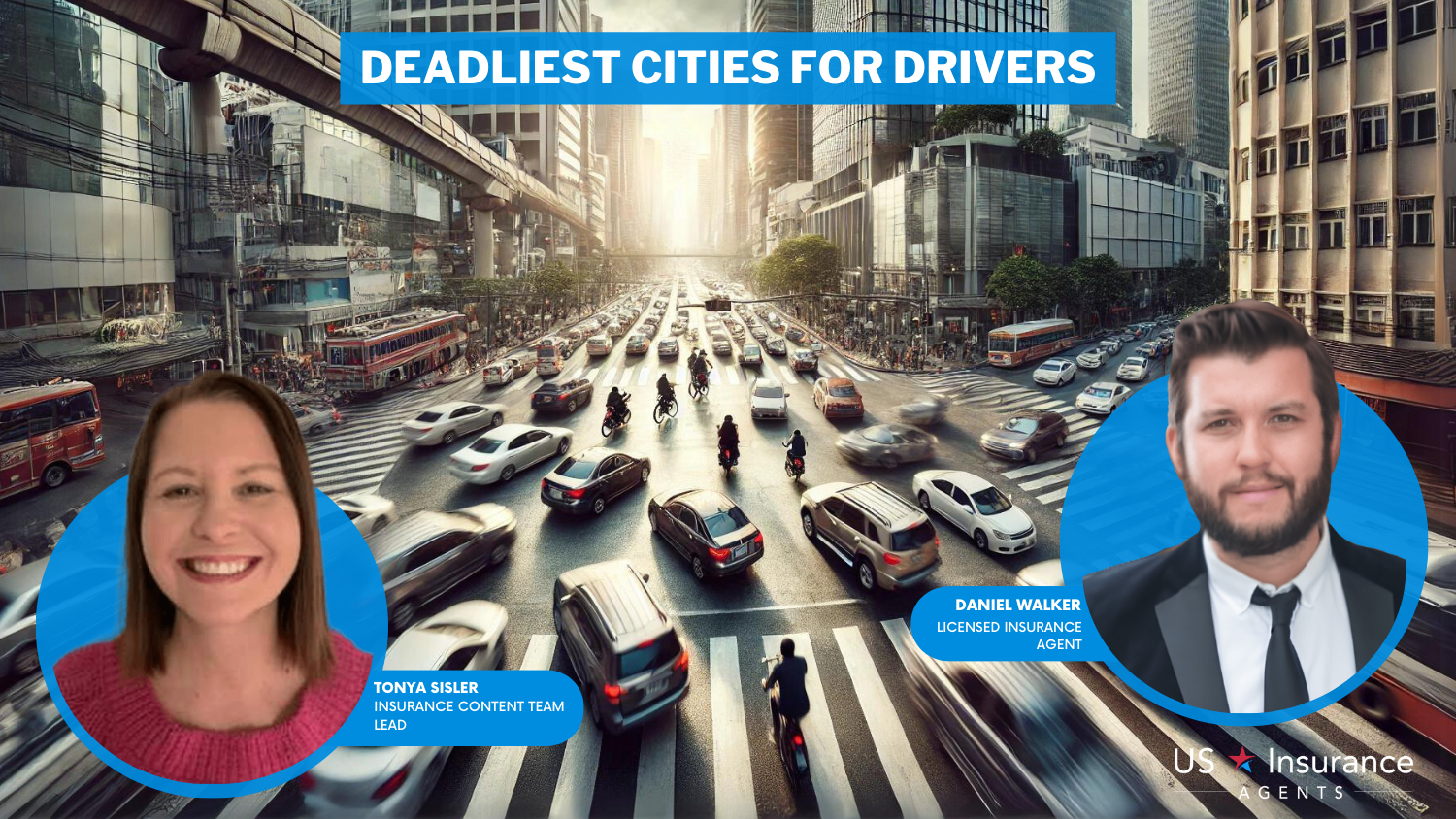
Frequently Asked Questions
Which city has the most car accidents?
The city with the most car accidents can vary year to year, but cities with large populations and heavy traffic, such as Los Angeles or Houston, often top the list. Local traffic conditions, road infrastructure, and population density all contribute to these high accident rates.
Which city has the highest number of car accidents in the US?
As of recent statistics, Los Angeles is frequently reported as the city with the highest number of car accidents in the US. This is largely due to its high population density and extensive network of roads.
Which state has the most car accidents?
California often reports the highest number of car accidents among US states. The state’s large population and heavy traffic contribute to its high accident figures.
Which state has the highest number of car accidents?
California is typically noted as having the highest number of car accidents. Its extensive roadways and large population size are significant factors in these high accident numbers.
Which state has the worst drivers?
While determining the “worst drivers” can be subjective, states like Louisiana and Mississippi have been reported to have high rates of traffic violations and accidents, which may contribute to this perception.
Which city has the highest rate of car accidents?
Cities with high accident rates per capita often include places like Atlanta and Miami, where factors such as traffic congestion and road conditions contribute to frequent accidents.
Which state has the highest car accident rate per capita?
States such as Mississippi and Louisiana have been reported to have high car accident rates per capita, reflecting the frequency of accidents relative to their population sizes.
Which states have the most car accidents?
States like California, Texas, and Florida are known for having high numbers of car accidents due to their large populations and extensive road systems.
In which city do the most collisions occur?
Cities like Los Angeles and Houston experience the most collisions due to their high traffic volumes and population densities, making them prone to frequent accidents.
Do most fatal crashes happen in cities or rural areas?
Fatal crashes can occur in both urban and rural areas, but rural areas often have a higher rate of fatal accidents due to factors like higher speeds, less road infrastructure, and longer emergency response times.
Can a minor drive another minor in California?
What are the 10 deadliest cities for drivers?
How does living in one of these cities affect my car insurance rates?
What can I do to lower my car insurance rates if I live in a high-risk city?
Are there any specific types of coverage I should consider if I live in a high-risk city?
What should I do if I am involved in an accident in a high-risk city?
Are there any specific safety tips I should keep in mind if I live in a high-risk city?
Who are the most dangerous drivers on the road?
Get a FREE Quote in Minutes
Insurance rates change constantly — we help you stay ahead by making it easy to compare top options and save.
